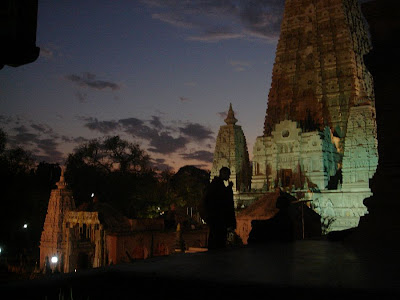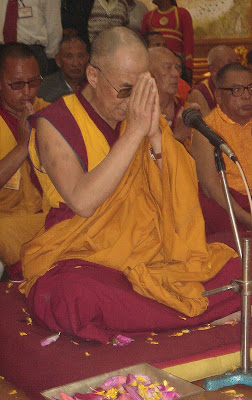Bodh Gaya, Bihar
All the signs seem to be pointing to my imminent departure from the Land of Enlightenment
 (Bodh Gaya), at least for the moment. Two nights ago, I came to retrieve my bicycle and someone had inexplicably wrenched the chain off track, and twisted the handlebars. (It was parked in the closed lot of the Temple Management Committee offices.) It didn't get that way by itself.
(Bodh Gaya), at least for the moment. Two nights ago, I came to retrieve my bicycle and someone had inexplicably wrenched the chain off track, and twisted the handlebars. (It was parked in the closed lot of the Temple Management Committee offices.) It didn't get that way by itself.It was 6.20 at night, just after sunset.
Minutes after getting the bike fixed with the help of the Committee watchmen (I gave them a tip), I was biking between brightly-lit Kalachakra Corner and Mohammed's restaurant. Just riding my bike, ho de do... stopped to get my bearings on a darker stretch of the road. "What the hell?" I yelled as out of nowhere, a kid ran up, grabbed my breasts from behind, then jumped onto a motorcycle (driven by another waiting guy) and sped off. I pedaled furiously after them, but they disappeared into main road traffic.
The police had to be convinced to file a report ("you were not harmed, Madame, and your valueables were not stolen"). In my best Indian English, I insisted calmly but firmly- "Inspector, 'Eve-teasing' is a crime under Indian law. It is my duty to report such a crime. If you do not wish to help me, I must go to my Embassy." They reluctantly got out pen and paper.
The first five times I stated my intention to file a report, the SubInspector exclaimed "What?!" as though he didn't understand. Later it transpired that he actually spoke very good English. It was difficult to tell whether they were afraid to have such an incident go on record on their watch, just didn't want to lift a finger to do any work, or perhaps both.
I went directly to the Bodhi Tree and sat in total bliss. A group of Thai pilgrims has
I felt safe, loved, and not at all angry or even frustrated. It's true, I wasn't hurt physically, and maybe it served as a good warning - that the deserted areas even in and around the peopled ones are not safe.
Rude Awakening
The very next morning brought a knock on my door at 7.30AM. The monk-in-charge (Bhante Rashtrapala, a Bangladeshi) of the meditation centre had sent an orderly to fetch me. Though there is not a single other soul in the entire guest house, Bhante insisted I had to vacate ASAP. "There is a big group coming," he insisted. Okay, what day are they coming? "Different days, different times." And you can't tell me when the days and times are? Then he finally said - "You have been here 40 days, you cannot stay so long here - this is a tourist place" (it is? I thought it was a meditation centre and monastery). At that point two very reverent young Indian (or Bangladeshi) people came in and bowed solemnly to Bhante, heads touching the floor. "I have to talk to them now," he said, and dismissed me with an impatient wave of the hand. There was no arguing with him - I must be out by the 12th.
Well, that's final. Guess he has to make way for more appropriately subservient guests. I returned to the police station to retrieve my copy of the FIR report. But the power was off and they couldn't make a photocopy.
Ni hao do you do?
The sitemeter is showing an increasing number of viewers from Mainland China - surprising, since I discuss His Holiness the Dalai Lama so much. Either the censorship is slipping, or these viewers know a way around the Great Firewall. Or, perhaps they are government spies, keeping an eye on radical upstarts like myself.
During the recent Monlam, I met an entire group of Karmapa devotees from Mainland China. This is quite remarkable, considering that following the Karmapa's escape from Chinese-held Tibet into India, China's official position is that the Karmapa is being misled and brainwashed by nefarious parties, and that in fact one should follow their "Karmapa" - an imposter with a similar name (they even gave him eyeglasses), currently stationed in West Bengal. Of course, these devotees could also be spies, or there could be spies among them. But I don't think so - I interviewed the group leader, who is a passionate vegetarian, and his friend who was sufficiently motivated to open a vegetarian restaurant in Beijing. Tibetan Buddhism is gaining popularity in China, along with Chinese government attempts to supplant authentic lamas and teachers with those of their own invention. They do the same with the Catholic church (they have their own, "official" Catholic church). I commend the Chinese Buddhists who are daring to think and act for themselves.
Just a little background on the continuing situation in Chinese-held Tibet; this, from an independent source published on Phayul.com.:
Beijing is continuing to crack down on expressions of Tibetan cultural identity and loyalty to the Dalai Lama. One source described how their attempts to promote Tibetan language in schools was shut down because officials saw it as a veiled attempt to promote Tibetan nationalism. In June 2006, the Chinese-controlled government in Tibet started yet another “anti-Dalai L
 ama” campaign, requiring handwritten and verbal denunciations of His Holiness by Tibetans with government jobs. These same employees are forbidden to circumambulate the Linkhor or they will lose their salary; people who disobey have been confronted with surveillance photographs of them on the Linkhor. I heard one unconfirmed report that officials plan to turn the Barkhor area of Lhasa into a “living museum” by evicting over 2,000 families, thereby emptying the last remaining part of Lhasa that is still largely Tibetan. I address instances of economic discrimination against Tibetans in Section C below. All these examples point to a deliberate policy to simultaneously hold down the Tibetans while promoting the demographic primacy of ethnic Chinese.
ama” campaign, requiring handwritten and verbal denunciations of His Holiness by Tibetans with government jobs. These same employees are forbidden to circumambulate the Linkhor or they will lose their salary; people who disobey have been confronted with surveillance photographs of them on the Linkhor. I heard one unconfirmed report that officials plan to turn the Barkhor area of Lhasa into a “living museum” by evicting over 2,000 families, thereby emptying the last remaining part of Lhasa that is still largely Tibetan. I address instances of economic discrimination against Tibetans in Section C below. All these examples point to a deliberate policy to simultaneously hold down the Tibetans while promoting the demographic primacy of ethnic Chinese.And, more background, and an update on the responses from the Tibetan diaspora in this excellent Rolling Stone feature. I hope this author wrote under an assumed name - otherwise, he most definitely will never get another Chinese visa.
The Man's Still Banned
His Holiness the Dalai Lama is still banned in, among other places, Kenya and Cambodia. It's just pathetic what people will do for Chinese money. As my friend Ardith says, "I think his goodness frightens some people. "


















